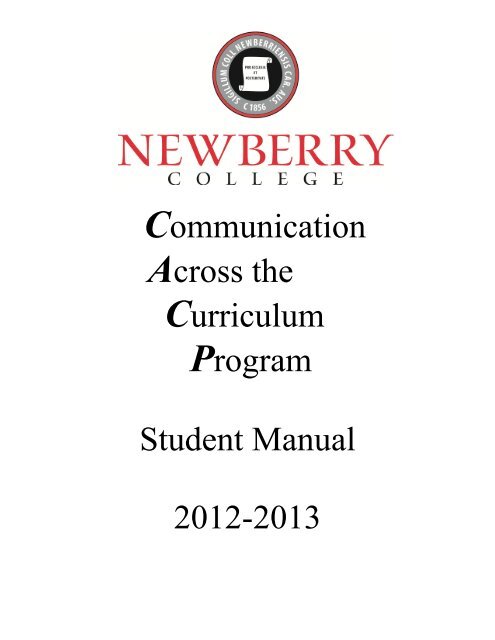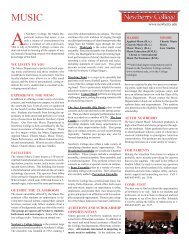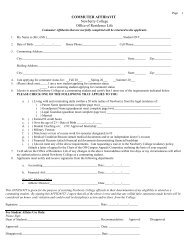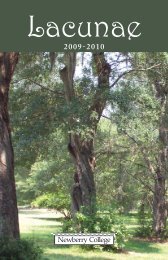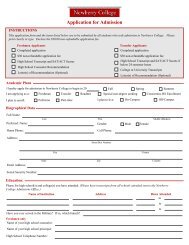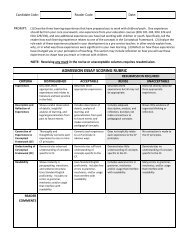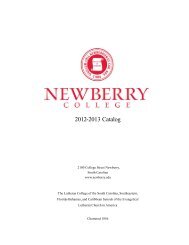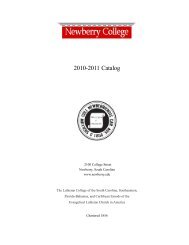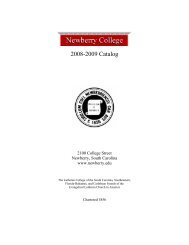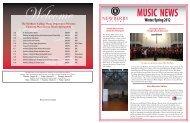Student Manual (2012-2013 PDF) - Newberry College
Student Manual (2012-2013 PDF) - Newberry College
Student Manual (2012-2013 PDF) - Newberry College
You also want an ePaper? Increase the reach of your titles
YUMPU automatically turns print PDFs into web optimized ePapers that Google loves.
Office of Academic AffairsHolland Hall, 321-5110Dear <strong>Newberry</strong> <strong>College</strong> <strong>Student</strong>s,<strong>Newberry</strong> <strong>College</strong> is committed to providing its students with the tools to succeed in collegeand to enjoy the full richness of life after college. Well-honed skills of listening, reading,speaking and writing are essential characteristics of an educated person who lives a fulfillingand meaningful life in our pluralistic, global community. These communication skills are thebedrock upon which all education rests. The only way we can assess your knowledge andyour abilities to comprehend, interpret and analyze information—key skills we expect you todevelop during college—is by examining what you say and what you write.We take seriously our obligation to help you develop your communication skills. The“Communication Across the Curriculum Program” (CACP) represents the college’s commitmentto help you develop your wring skills as fully as possible. This manual describes theCACP requirements at each level as you pursue your coursework during your career at<strong>Newberry</strong> <strong>College</strong>. Please read it at your earliest convenience to get the maximum benefitfrom this program.We hope you discover what Ernest Boyer, President of the Carnegie Foundation, describedwhen he wrote:Writing holds us responsible for our words and ultimately makes us more thoughtfulhuman beings. As students put their ideas on paper, they improve their understandingand discover both the discipline and joy of self-expression. (<strong>College</strong>: The UndergraduateExperience in America, 1987)Your professors and other college personnel stand ready to help you through your CACPrequirements and other college programs. Our goal is to enable you to succeed in your studiesand obtain the preparation that you will need to respond thoughtfully, creatively and with clarityto the ever-changing needs of our region, the nation and the world. We want to “make adifference” in your life so you can make a difference in the lives of others.Yours sincerely,Timothy G. ElstonTimothy G. Elston, Ph.D.Interim Executive Vice President for Academic Affairs2
Table of ContentsIntroduction: Communication Across the Curriculum………………...……...………….. 4CACP Policies for Special Situations:(Exemption, Dual-Degree <strong>Student</strong>s, Transfer <strong>Student</strong>s, Appeals)……………………. 5Level 1:Explanation of Procedures………………………………………..………………… 6Explanation of Assessment Criteria……………………..……………………….…. 6Level 2:Explanation of Procedures…………………………….……………………….…… 7Writing Assessment Criteria…………………………..……………………..……… 8Level 3:Explanation of Procedures……………………………..……………………..…… 11Critical Thinking Endorsement…………………….……………………………… 12Writing Assessment Criteria by DepartmentArt……………………………..………………………………………………..… 14Biology and Chemistry………….. …………….……………………...… 15Business Administration……………………………….………………………. 16Communications………………………..…………………………………..…... 16Education……………………………………….……………………………… 18English………………………………………………….…………………….... 19Foreign Languages………………….…………………………………………. 21Graphic Design…………………….…………………………………………… 21History………………………………..………………………………………… 22International Studies & Commerce…………………………...…………….…. 24Mathematics………………………………………………….………………..… 24Music………………………………………………….………………………… 25Nursing Program…………………………………...…………………………..… 26Physical Education……………………………………..………………………. 27Political Science………………………………….……………………….……… 28Psychology……………………………………………………………...…….. 31Religion and Philosophy/Church Leadership………………….………...……. 32Sociology………………………………..………………………………....…… 33Theatre/Speech………………………………….……………………...……… 35Sources for Additional Information…………………………………..……………..……. 36Policy on Academic Honesty………………………………….…………………..……... 37<strong>Student</strong> Checklist for CACP Certification………………………………….……..……... 38Appendix: Inclusive Language Guidelines……………………………..…………………. 393
Introduction: Communication Across the CurriculumCommunication is basic to all human activity. Your success in anything—a college course, extracurricularactivity, personal relationship, or a career—will depend on your ability not only tothink and act, but also to process ideas and communicate them to others. An education thatasked you to memorize facts but not analyze and express them would be useless.Your studies at <strong>Newberry</strong> <strong>College</strong> will challenge you not only to learn but also to communicate.One major learning tool to meet this challenge is the “Communication Across the CurriculumProgram” (CACP). By providing opportunities for you to use your communication skills at alllevels of college work, CACP helps you use written work to sharpen and demonstrate yourabilities to express yourself in different situations for different audiences. CACP activities aredivided into three categories:Level 1: At this level, you show your ability to write standard English at the college level. <strong>Student</strong>swho pass English 111 with a “C” or above demonstrate Level 1 skills and are ready towrite Level 2 papers.Level 2: You will write your three Level 2 papers in such courses as ENG 112 (not in ENG111) or other introductory courses in various subjects. See list of academic areas on page 3.These papers build upon Level 1 skills to communicate on different topics.Level 3: Having mastered Level 1 and 2 skills, you will write three papers in courses withinyour academic major, demonstrating your mastery of the vocabulary, methods, and techniquesof that major.This manual describes the specific steps you will take to complete the Level 1 through 3 requirements,which you must complete to graduate from <strong>Newberry</strong> <strong>College</strong>. Your completion ofthis work will confirm not only that you have mastered a body of knowledge, but also that youhave the skills to communicate that knowledge. Whatever you do after college, your <strong>Newberry</strong>diploma will be testimony to prospective employers, graduate schools, and others, that you havethe communication skills needed for personal and professional success.While not constituting a “contract,” this manual outlines the agreement among <strong>Newberry</strong> <strong>College</strong>faculty, staff, and students to provide the resources, direction, and encouragement neededfor you to develop and demonstrate your communication abilities, and to fulfill the CACP requirements.This manual is divided into the following sections:Explanation of procedures and criteria for Level 1-3 RequirementsSupplementary information (checklist, academic honesty)If you have any questions not answered by this manual, or if anything in the manual is unclearto you, check with any of the faculty and staff members listed “Sources for Additional Information”(page 36).4
CACP Policies for Special SituationsAll <strong>Newberry</strong> students must pass CACP Level 1, and most are required to pass all requirementsfor Levels 2 and 3. The only exceptions are:Dual-Degree Program <strong>Student</strong>s<strong>Student</strong>s who enroll in Dual Degree programs with other accredited universities and institutionsmust complete the following CACP requirements:- Two years at <strong>Newberry</strong>: Level 1, three Level 2 papers, and one Level 3 paper- Three years at <strong>Newberry</strong>: Level 1, three Level 2 papers, and two Level 3 papersTransfer <strong>Student</strong>s (including those enrolled in the <strong>Newberry</strong> <strong>College</strong> fastFORWARDAdult Degree Program)Level 1. <strong>Student</strong>s who transfer English 111 from another accredited institution completethe CACP: Level 1 requirement. Transfer students whose writing needs improvementmay be required to enroll in ENG099 or to work with a writing assistant in the Center for<strong>Student</strong> Success for a designated length of time.Level 2. <strong>Student</strong>s transferring to <strong>Newberry</strong> <strong>College</strong> may meet CACP: Level 2 requirementsby writing one Level 2 paper (instead of the usual three) provided that they meetall of the following requirements:--The student must transfer in at least 56 semester hours.--The student must have completed ENG 111 and/or ENG 112 (or the equivalent) with agrade of “C” or above.All <strong>Newberry</strong> students are required to complete Level 3 requirements as defined in theCACP <strong>Student</strong> <strong>Manual</strong>.Other Special Situations<strong>Student</strong>s who plan to graduate in <strong>2012</strong>-<strong>2013</strong> and who feel that unusual circumstanceshave prevented their completing CACP requirements must submit a written appeal (in theform of a letter) to Professor John Carenen, Director of CACP, with specific documentationciting the circumstances preventing their satisfactory progress in CACP. For prospectiveDecember graduates, paperwork must be in Professor Carenen’s possession byNovember 1st. For prospective May graduates, paperwork must be in ProfessorCarenen’s possession by April 2nd.Other students who feel that unusual circumstances have prevented their completingCACP requirements must submit a written appeal (in the form of a letter) during the firstsemester of their attendance at, or reentry to, <strong>Newberry</strong> <strong>College</strong> to Professor JohnCarenen, Director of CACP, with specific documentation citing the circumstances preventingtheir satisfactory progress in CACP.5
Level 1: Explanation of ProceduresAccording to college policies when you enter <strong>Newberry</strong> <strong>College</strong>, students are placed into*English 099: Basic Composition and Grammar (an elective-credit course) or into English111: Freshman Composition and Research (a three-credit hour, college-level course)based on SAT/ACT verbal scores and GPA in high-school English courses. <strong>Student</strong>splaced into English 099 work to develop their writing skills (focus, content, organization,style, mechanical conventions) so that they can be eligible to enroll in appropriate college-level English courses. Once students pass English 111 with a “C” or above, they alsopass CACP Level 1 and can begin submitting CACP: Level 2 papers.*Note: English 099 does not count toward the number of hours required for a Life Scholarship.Level 1: Explanation of Assessment CriteriaFollowing are the basic writing skills that students must demonstrate in their Level 1 and2 papers. The list that follows does not repeat the full explanations found in your collegehandbook (The St. Martin’s Handbook), but it does tell you where you can find explanatorychapters in this text.FOCUS (SMH: chs. 5-8, )Consistency and clarity in identifying and maintaining main idea or point of viewCONTENT (SMH: chs. 1-3, 61-66)Extent to which topic is addressed by the development of ideas and the specificityof details and experiencesORGANIZATION (SMH: chs. 5-6)Unity and coherence achieved through logical sequence of ideasSTYLE (SMH: chs. 26-29, 42-45)How effectively the chosen language enhances the writer’s purpose—e.g., clear andvaried sentence structure and precise word choiceMECHANICAL CONVENTIONS (SMH: chs. 31-35, 36-41, 46-51, 52-55 )Control of mechanics in grammar, usage, spelling, and punctuation6
Level 2: Explanation of ProceduresCACP: Level 2 papers should be completed, submitted, and certified by the end of a student’ssophomore year. Level 2 writing skills require students to go beyond the grammarand mechanics of Level 1 toward effective presentation of logically developed, sustainedideas. <strong>Student</strong>s must demonstrate Level 2 writing skills by writing three acceptable papersin different subjects. In other words, students who write their first Level 2 paper inEnglish could complete the other papers in (for example) Biology and Religion. The studentcould not complete two Level 2 papers in a single field, however. For Level 2 papers,the different subjects are:Art History PhysicsBiology Foreign Languages Political ScienceChemistry Honors * PsychologyCommunications Graphic Design ReligionOnly one from business: Mathematics SociologyBus. Adm./Acct./Eco. Music SpeechEducation Philosophy TheatreEnglish Physical Education Nursing*Honors faculty will note field of certification on the student’s Level 2 cover sheet.Participating faculty judge these papers by a list of general criteria listed on pages 8-10 ofthis manual. Every professor is encouraged to participate in CACP by allowing studentsto complete one of the three Level 2 papers as a component of the course. These papersare not likely to differ much from those regularly required by professors throughout theircourses. Professors will state in their syllabus whether writing for their classes may beused for certification in CACP. <strong>Student</strong>s should ask the professor about CACP if there isno statement in their syllabus.Once students have ascertained that the professor is participating in this program, theymust:1. Inform the professor of their intent to write a Level 2 paper.2. Follow the professor’s guidelines and meet all agreed-upon dates.3. Consult the Level 2 Assessment Criteria on pages 8-10 and use themas a checklist.4. Submit the final draft with evidence of student work and thecertification form to the professor.5. Have the professor initial and date the student’s CACP record.7
If the paper satisfactorily meets the professor’s standards as measured by the Assessment Criteria, theprofessor will sign the CACP Writing Certification Record, indicating that the paper meets Level 2 certificationand will submit the form and the paper to the Office of the Registrar in Holland Hall.Please note that the process of completing papers for certification at Level 2 (or Level 3) is not directlyrelated to the final grade a student will receive in a given course. In other words, a student may satisfyLevel 2 (or Level 3) criteria with a particular paper and still perform poorly overall in a course. Or astudent may fail to meet Level 2 (or Level 3) criteria in a particular paper, yet perform relatively welloverall in the course. It is important to keep CACP performance and grading for a course in perspectiveto avoid confusion for both student and professor.Level 2: Writing Assessment CriteriaI. To be considered for Level 2 certification, a paper (report, term paper, or other written assignment)must be at least one typed page in length (most are three or more pages) and:A. Be submitted to a professor during the semester in which students are enrolled in the designatedcourse; furthermore, these papers must receive final approval during the semester the course is takenor, at the professor’s discretion, before Reading Day of the following semester;B. Be submitted in a format designated by the professor, including a draft or other evidence of prewriting;C. Be the original work of the student submitting it—no group-written papers;D. Bear the name of the student submitting it and the course for which it was submitted;E. Have a student-completed CACP Level 2 cover sheet (a copy of this form is attached to thisdocument; extra copies are available online at www.newberry.edu/academics/cacpprogram.asp,outside of McClurg 117 and McClurg 109 in the McClurg Center);F. Be completed by the end of the student’s sophomore year, except for transfer students whomust establish a timeline with their advisor and with the Director of CACP.Education students should check page 18 for specific Level 2 requirements.II. Criteria for assessing Level 2:A satisfactory Level 2 paper…Narrows a given subject to a manageable levelBefore a subject can be narrowed, it must be explored through initial research and “pre-writing”techniques. The final length of the paper, the number of library sources and amount of dataavailable, the kind of information available, and the student’s familiarity with the subject will allplay a part in determining the “manageable level” of a subject.Is written in an appropriate “discourse” and styleIn traditional rhetoric, the modes of discourse describe the primary purpose behind the writing.Generally, they are considered to be narration, exposition, and argumentation (Lindemann 18).This criterion simply requires that the paper be written in a form, style, and structure appropriatefor its purpose and audience. Also, see the Appendix on “Inclusive Language Guidelines” (page39).Address the topic clearly and directlyA common weakness in student writing is the tendency to write three or four opening paragraphsbefore finally addressing the topic. Make certain that your Level 2 project clearly identifies itstopic early in the paper, and sticks to that topic throughout.8
Presents a cogent thesis or statement of purposeA thesis statement is a sentence that explicitly or implicitly expresses the author’sopinion about the topic. It should contain enough information to delineate clearlythe specific area to be discussed, and it must be demonstrable through argument andevidence. A statement of purpose should clarify the goal and content of the paper.Presents supporting ideas in a clear, logical structureThe organizational pattern of the entire paper will often be determined by the thesisstatement and rhetorical mode. For example, narrative essays will follow a chronologicalpattern, while descriptive essays might follow a spatial order. Expositionand argumentation essays could follow a “break-down” order (for example, classificationor analysis) or an organizational pattern that establishes relationships(comparison/contrast, analogy).Develops paragraphs by use of concrete detailWhile there are paragraphs that act as transitions between larger sections of a pieceof writing, most body paragraphs take their substance from the concrete detail usedto support their topic sentences, which in turn support the thesis sentence. Some effectivemethods of support are explanation, comparison and contrast, illustration,specific instance, statistics, testimony, and restatement (Ehninger et al. 106-118).To determine whether a paragraph is adequately developed through the proper useof supporting material, the reader may question each statement. If a statement isdebatable and allows the reader to question it, it is probably not concrete enough toconstitute evidence in support of the thesis statement. Argumentation may be builtupon opinion, but it must ultimately be grounded upon fact.Has a smooth, logical flow of thought both within and between paragraphsThe logical flow of thought is called “coherence.” According to Lynn QuitmanTroyka’s Handbook for Writers:A paragraph is coherent when its sentences are related to each other, not only incontent but also in grammatical structures and choice of words. Techniques thathelp to make paragraphs coherent include using transitional expressions, using pronouns,repeating key words, and using parallel structures (83).9
Employs vocabulary and style appropriate for the intended audienceDefining the audience is an important step in the composing process. The audiencewill determine the diction, vocabulary level, length of the sentences, depth of thesubject matter, intricacy of argumentation, and length of the final paper. The intendedaudience should be determined early in the writing process; it will continueto have an effect on the writing through subsequent drafts, final revision and editing.(Note: See related comments in the Appendix on “Inclusive Language Guidelines,”page 39).Is generally free of misspelled words; blatant errors in grammar,usage, and punctuation; and typographical errors and “strike-overs”Includes complete and accurate attribution (in the appropriateformat) of all material quoted directly or paraphrased. (See <strong>Newberry</strong><strong>College</strong> <strong>Student</strong> Handbook, “Policy on Academic Honesty.”)Different disciplines use different forms of citation. Make certain that you understandcitation and documentation standards taught in ENG 111 and 112 and in thesubject in which you are writing your paper. If you are uncertain about these matters,see a college writing handbook or consult an instructor.Works CitedEhninger, Douglas, Bruce E. Gronbeck, and Alan H. Monroe.Principles of Speech Communication. Glenview, IL: Scott, Foresman, 1980.Lindemann, Erika. A Rhetoric for Writing Teachers. New York: Oxford UP, 1987.Lunsford, Andrea and Robert Connors. The New St. Martin’s Handbook.Troyka, Lynn Quitman. Handbook for Writers. Englewood Cliffs, NJ: Prentice,1987.10
Level 3: Explanation of ProceduresCACP: Level 3 papers should be completed, submitted, and certified by first semester ofa student’s senior year. Level 3 writing skills are demonstrated in the major and are definedand evaluated by each department (See Level 3 criteria, pages 11-35). <strong>Student</strong>smust submit three satisfactory Level 3 papers from major courses to qualify for graduation,with the following exceptions:-<strong>Student</strong>s with double majors may complete their three papers in either or both majors.-Some departments have major writing assignments that count for more than one paper(for example, satisfactory papers of 10 or more pages written in 300-or 400-levelcourses in Communications can, with the instructor and department chair’s permissionbe counted for two Level 3 papers). See your department chair for further information.[Note: Professors who certify two-credit papers must write and sign a statement tothat effect at the top of the student’s Level 3 cover sheet so that the Records Coordinatorproperly credits the paper.]-<strong>Student</strong>s with a minor as well as a major can write one Level 3 paper in the minor.-<strong>Student</strong>s completing requirements for teacher certification in a content area may writeone Level 3 paper in an Education course.These procedures govern Level 3 papers:-<strong>Student</strong>s must have written and passed at least one Level 2 paper before attemptingLevel 3.-<strong>Student</strong>s must submit Level 3 papers to their professors during the semester in whichstudents are enrolled in the designated course; furthermore, these papers must receivefinal approval during the semester the course is taken or, at the professors’discretion, before Reading Day of the following semester.-All Level 3 papers should be completed by the first semester of a student’s senioryear, unless otherwise designated by departmental guidelines.-Papers written as group projects will NOT be accepted unless individually designatedstudent-written sections meet length/content requirements, and then only with priorapproval from the Director of CACP.Seniors should note that all CACP papers must be revised and certified byReading Day; none will be accepted after that day.11
As with Level 2 papers, individual professors will announce at the beginning of the semesterif Level 3 papers may be submitted in a particular course. If an announcement isnot made, students should ask the professor if Level 3 papers will be accepted. Once studentsknow they can write a Level 3 paper in a particular course, they should request copiesof the appropriate Level 3 assessment criteria developed for each major area. At thatpoint students should essentially follow the Level 2 process (page 7).If the paper is approved for Level 3, the professor will submit the final paper with thesigned Level 3 cover sheet (to be completed by the student and turned in with the finalpaper) to the Office of the Registrar in Holland Hall.A copy of the official Level 3 form is enclosed in this booklet; extra forms are availableon the <strong>College</strong>’s website, in the CACP Office (Room 117, McClurg), the McClurg StaffSupport Office (Room 109, McClurg), .Additional information about Level 3 requirements can be secured from DepartmentChairs, whose names, offices, and telephone numbers are listed on page 36.CRITICAL THINKING ENDORSEMENT (Required for Level 3)<strong>Student</strong>s should note that the Certification Form for Level 3 includes a “Critical ThinkingEndorsement,” which is a part of the certification process at Level 3.“Critical Thinking” is one of the most important topics addressed in your college education.Ironically, it is also one of the most difficult terms for students and faculty to define.One problem is that approaches to critical thinking differ from one discipline to another:for example, approaches to critical thinking in the visual arts seem very different fromthose used in computer programming.Nevertheless, many of the important elements of critical thinking across the curriculumare similar, and your Level 3 papers should demonstrate your ability to analyze problemsand solve them. When you complete your Level 3 certification form, you will describethe Critical Thinking skills that you used to complete the assignment in a “Critical ThinkingEndorsement.”In general, your statement should describe:The objective(s) or problem(s) that form the basis for your paper’s thesis.The analytical skills and methods that you used to solve your project’s problem(s) ormeet its objective(s).The conclusion that your methods produced.12
Following is a detailed outline of topics that might be addressed in a Critical Thinking activity.Feel free to use this outline to complete your “Critical Thinking Endorsement,” orany other appropriate methods that you have learned in the core curriculum and your majorcourses. Refer to the explanation of these critical thinking skills in the online versionof the CACP <strong>Manual</strong>: http://www.newberry.edu/academics/cacpprogram.aspCritical Thinking is the ability and willingness to manage the mental processes necessaryto reach decisions, make judgments, solve problems, and construct and communicatemeaning. These ends are served by developing strategies for applying the appropriateskills selected from the following:*Observing*Comparing and contrasting*Identifying cause and effect*Summarizing*Generating ideas*Recognizing fact or opinion*Recognizing bias*Recognizing underlying assumptions*Analyzing*Inducing*Questioning*Classifying and Sequencing*Inferring*Synthesizing*Recognizing purpose*Recognizing tone*Recognizing organization*Evaluating*DeducingSee explanation of explanation of these critical thinking skills in the online version of theCACP <strong>Manual</strong>: http://www.newberry.edu/academics/cacp.asp.13
Art: CACP Level 3 RequirementsBefore attempting a Level 3 paper in Art, students must have completed and recorded atleast one CACP: Level 2 paper.There are three components to Art Department requirements for CACP Level 3. Theseinclude but are not limited to:A. The successful completion of a body of artwork produced while a student at<strong>Newberry</strong> <strong>College</strong>,B. The selection and presentation of artworks from this body of work to be exhibited inone of the college’s art galleries during or prior to the final semester that the student isenrolled in art courses at <strong>Newberry</strong> <strong>College</strong>,C. The presentation and display of biographical text and informative, descriptive text ortexts alongside of the artwork (also referred to as the artist’s statement/s).The following guidelines apply:A. Completion of artwork:Any work completed during the student’s tenure as undergraduate art student that isconsidered to be in a finished state.B. Selection and presentation of artwork:Selection of artworks to be exhibited will take place in consultation with that student’smajor professor. The task of making the artwork presentation-ready will be on the student.C. The artist’s statement/s:The text should be written clearly and typed. The text should include a brief biographywhich includes birth date, education, employment (if related), awards, exhibitions,notes on the artist’s residence and moves from one city to another, etc. The artist’sstatements should be brief and concise noting the artist’s influences, interests, and anyfactors that contribute to or help explain the artwork not excluding processes or workinghabits. These statements may include quotes from other artists but these shouldnot make up the main body of the text. The text should be made presentable and displayedalong with the artwork in the gallery in such a way that the viewer can comfortablyread it.14
Biology and Chemistry: CACP Level 3 RequirementsBefore attempting a Level 3 paper in Biology, Chemistry, or Forensic Science, studentsmust have completed and recorded at least one CACP: Level 2 paper.I. Each Paper Must Fulfill the Following:A. Be typed, doubled spaced and in 12-point or smaller font,B. Be a minimum of five (5) pages in length, excluding charts/graphs and literaturecited, andC. Include at least five (5) references, typically from journals (Internet or othersources may be used at the discretion of the professor).Professors have the option of adding additional criteria specific to their courses.II. Proper Use of References:Each paper must include proper reference(s) to the scientific literature. Referencesmay possibly be obtained from journals, books, the Internet, or other sources; however,a specific assignment may be more restrictive. The specific methods for developmentand use of references within papers will vary from course to course, so check thecourse syllabus or other handout.III. Critical Thinking Endorsement:As is typical of any Level 3 paper submitted for CACP, an appropriate cover sheetneeds to be attached and the critical thinking section completed with informationpertaining to:A. A statement of the thesis or hypothesis,B. Sources of information used to define a thesis or set the hypothesis(e.g. journals, Internet, scientific monograph),C. Mechanisms by which the thesis is supported or the hypothesis is tested(e.g., support from six (6) Internet sources; references in journal articles,personal data collected in lab), andD. Basis on which the conclusion for the paper is stated.In addition, it is expected that a final CACP Level 3 paper include the first version ordraft of the paper unless, of course, the paper was accepted on the initial submission.15
Business Administration: CACP Level 3 RequirementsBefore attempting a Level 3 paper in Business Administration, students must have certifiedat least one CACP: Level 2 paper.1. General Composition: Written materials must display proficiency at least at the Level1 and 2 criteria.2. Grammar and Mechanics: Written materials must satisfy Level 1 and 2 criteria forstandard English grammar and mechanics. See The St. Martin’s Handbook and/or Turabian’s<strong>Manual</strong> for Writers of Term Papers (see #5, below).3. Information Search: <strong>Student</strong>s must present, within the paper, evidence of proficiencyin using the various indexes and periodicals. Appropriate indexes include: BusinessPeriodicals Index, Wall Street Journal Index and the Social Sciences and HumanitiesIndex.4. Organization: Written materials must be organized according to accepted proceduresand principles for effective business writers. These procedures may be ascertained byreviewing formats in professional journals/publications.5. Documentation: Because Business Administration includes many sub-disciplines thatrequire different research formats, students must consult their professors about the approveddocumentation format (Turabian, APA, MLA, CBE, etc.) for each course.6. Audience Definition: Writing should be geared toward the business reader in particular.Communications: CACP Level 3 Requirements<strong>Student</strong>s must have completed at least one Level 2 paper before submitting a Level 3 paper.I. Level 3 documents for the Communication major (reports, term papers, or otherwritten assignments) must be:A. At least three (3) double-spaced, typed pagesB. Submitted in a designated communications courseC. Submitted by or on the assigned or agreed-upon dateD. The original writing of the student submitting the paperE. A formal paper submitted in a format specified by the professorII. General Composition: Written materials must satisfy criteria for Level 1 and Level 2.16
III. Information Search: The extent and purpose of your research will depend on thecourse and the instructor’s specific requirements. The following are general guidelines:A. <strong>Student</strong>s must demonstrate the ability to use relevant abstracts and indexes insearching for information. Examples include: Business Periodicals Index, EducationIndex, Public Affairs Service, Resources in Education and Social Sciences Index.B. <strong>Student</strong>s must demonstrate the ability to present a review literature consistent withthe format found in Communication Research, Journal of Broadcasting & ElectronicMedia, Journal of Communication, and Journalism Quarterly.C. In a research paper, students must demonstrate the ability to conclude a review ofliterature with a relevant hypothesis.IV. Organization:A. <strong>Student</strong>s must demonstrate the ability to develop a thesis statement. They must presentthe relevant literature search findings. This must be followed by a presentationof a thoughtful and well-constructed discussion of the issues involved. The papermust include a conclusion or summary of the issues consistent with the presentationof evidence.B. In a research paper, students must demonstrate the ability to integrate tables, charts,and figures into the text so that they contribute to the reader’s understanding.C. <strong>Student</strong>s should consult individual instructors for additional materials on organizationalskills.V. Audience Definition:<strong>Student</strong>s must demonstrate the ability to write for a variety of audiences depending onparticular assignments. Possible audiences include college students, communicationsmajors, communications professionals, and the general public.VI. Documentation:Individual instructors will designate the most recent edition of one of the followingguides:A. MLA HandbookB. Turabian’s A <strong>Manual</strong> for Writers of Term Papers, Theses, and DissertationsC. The Chicago <strong>Manual</strong> of StyleD. The Associated Press Stylebook17
VII. Grammar and Mechanics:A. Lunsford, Andrea, and Robert Connors. The St. Martin’s Handbook.B. Hodges, John C., Mary E. Whitten, Winifred B. Horner, et al. Harbrace <strong>College</strong>Handbook. 11 th ed. San Diego: Harcourt Brace Jovanovich, 1990.C. Communications Across the Curriculum Program: <strong>Student</strong> <strong>Manual</strong>. Level 2 and 3:“Explanation of Procedures” and “Writing Assessment Criteria.” 2003-2004.D. Grammar for JournalistsEducation: CACP Level 3 RequirementsBefore attempting a Level 3 paper in Education, students must have certified at least oneCACP: Level 2 paper. Beginning on January 1, 2010, any teacher candidate applying forformal admission to the Teacher Education Program must have completed all Level 1 andLevel 2 CACP requirements. In an effort to assist in completing this requirement, therewill be a required level 2 paper in EDU 230, Human Development and Learning, whichall teacher candidates must complete with a C or better before applying for admission tothe Teacher Education Program.Beginning with the January 2010 internship, all Level 3 CACP papers must be completedbefore the beginning of the internship semester. A student intern will not be allowed tobegin the internship experience until all CACP papers are approved. Upper level educationclasses, as well as courses in the major, will provide opportunities for teacher candidatesto write Level 3 CACP papers.Most papers written in upper-level Education courses can be submitted forLevel 3 certification, if (1) the paper makes appropriate use of advanced skills instudying and examining education materials, and (2) the student has consultedwith the professor before submitting the assignment, and (3) the paper:(a) Is at least five(5) double-spaced typed pages;(b) Is submitted in a 300- or 400-level Education course;(c) Is the original work of the student submitting the paper;(d) Is submitted in Modern Language Association (MLA) format;(e) Meets all criteria for CACP Levels 1 and 2.Usually students must complete three (3) papers for Level 3. However, studentsinvolved in extensive research (for example, extended, highly specialized writing, such asa Senior Essay) may, with the instructor and department chair’s permission, request thatan exceptional paper be counted as the equivalent of more than one Level 3 paper.(Example: a student completing a research paper of 10 or more pages in a 300-levelcourse could request that the paper be counted as two Level 3 papers.) should prompt asearch for the original Phi Delta Kappan material: do not cite the Digest as a source.18
Research Guidelines:The extent and purpose of your research will depend on the course and the instructor’sspecific requirements. Some studies will require extensive background for guidance ininterpreting observed phenomena, behaviors, or practices; others will necessitate thecareful collection and interpretation of statistics; still others may demand research in allof these areas. Digests or commentary about the basis information or data are notacceptable substitutes for examining the publications in which the original materialappears. Hence, references to an article in Phi Delta Kappan that appears in EducationDigest should prompt a search for the original Phi Delta Kappan material: do not cite theDigest as a source.Sources:You should consult your instructor for suggestions about publications to be included inyour research, or for sources that you should avoid. In general, however, periodicalmaterials are more likely than bound books to provide fertile sources. For that reason,the Education Index is a likely beginning for most research undertaken to satisfy Level 3requirements.Audience Definition:<strong>Student</strong>s must demonstrate the ability to write for a variety of audiences depending onthe particular assignment. Possible audiences include college students, education majors,education faculty, and the general public.Documentation:Rosa, Alfred and Paul Eschholz. The Writer’s Brief Handbook or the current edition ofthe St. Martin’s Handbook.English: CACP Level 3 RequirementsMost papers written in 300- or 400-level English courses can be submitted for Level 3certification, if(1) the paper makes appropriate use of advanced skills in studying and examiningliterary texts, (2) the student has consulted with the professor before submitting theassignment and has completed at least one Level 2 paper, and (3) the paper:(a) Is at least five (5) pages doubled-spaced, typed in 10-12 point font;(b) Is submitted in a 300- or 400-level English course;(c) Is the original writing of the student submitting the paper;(d) Is submitted in the format specified by the professor;(e) Meets all criteria for CACP Levels 1 and 2.19
Usually students must complete three papers at Level 3. However, students involved inextensive research (for example, extended, highly specialized writing, such as a Senior Essay)may, with the instructor and the department chair’s consent, request that an exceptional projectbe counted as the equivalent of more that one Level 3 paper. (Example: a student completing aresearch paper of 10 or more pages in a 300-level course could request that the paper be countedas two Level 3 papers.)Research Guidelines:The extent and purpose of your research will depend on the course and the instructor’s specificrequirements. Some critical studies of primary works will require little in the way of secondaryresearch, but most papers will require some attention to the primary text cited (see “PrimaryText,” below). Research papers, on the other hand, will require substantial study of (for example)source materials or established critical commentary on the subject. Before you work on aLevel 3 paper, make your instructor aware of your intention to do so and seek specific guidelinesfor the project’s research needs.Primary Text:Critical analysis of literary texts requires that you work with reliable “critical editions” ofprimary works, or editions that result from scholarly analysis of source materials to produce areliable, unabridged critical text (for example, a research paper on Shakespeare’s plays shoulduse a critical edition, such as the 1986 Oxford Shakespeare). For advanced commentary on literature,trade paperback editions or translations may be unsatisfactory. Consult bibliographicsources below to locate appropriate editions of the literary text (s) under study.Secondary Sources:Basic sources on literary research include the New Cambridge Bibliography of EnglishLiterature (for texts and commentary in English literature up to 1950), and the MLA(Modern Language Association) International Bibliography (for general scholarship onnational literatures from different periods). For a detailed list of more specializedsources, ask the English Department chair.Audience Definition:<strong>Student</strong>s must demonstrate the ability to write for a variety of audiences depending onthe particular assignment. Possible audiences include college students, English majors,English professors, and the general public.Documentation:Unless the instructor specifies different requirements, documentation (identification ofsources consulted and cited) should conform to the MLA style, defined in the currentedition of The St. Martin’s Handbook as well as in the MLA Handbook and the MLA Style<strong>Manual</strong>. Most college handbooks provide complete details of current MLA documentation style.20
Foreign Languages: CACP Level 3 RequirementsBefore attempting a Level 3 paper, students must have certified at least one CACP:Level 2 paper. <strong>Student</strong>s should follow English guidelines on page 19, except thatforeign language Level 3 papers must be written in Spanish. No Level 3 papers will beaccepted in French or German since these two languages are no longer majors or minors.Graphic Design: CACP Level 3 RequirementsI. General Requirements1. All Level 3 papers must be typed, double-spaced and 10-point or smaller font.2. Papers must be at least five (5) pages in length not including pictures, artwork anddiagrams.3. All work must be submitted on or before the assigned date.4. Paper must satisfy criteria for all Level 2 standards in English grammar.5. Written material must be original to the student submitting the paper.II. Research Guidelines1. Specific reference guides include but at not limited to:a. Communication Artsb. Howc. Printd. Internet2. <strong>Student</strong>s must incorporate found information and use this information to create thewriter’s own text. Information should be organized and well thought out.III. OrganizationAll written work must be well constructed including an introduction, definition ofwork or designer, thesis statement and conclusion or summary of the ideas or issuespresented in the paper.IV.Audience DefinitionWritten work must be geared towards a general reader, design and/or art,majors or professionals working within the graphic design industry.21
History: CACP Level 3 RequirementsAt least one Level 2 paper must have been submitted before attempting a Level 3 paper.I. History papers for Level 3 might include reports, term papers, or otherwritten assignments of a length specified by the professor.Note this requirement: At least one Level 3 paper MUST be certified inHIS 450: Historiography, which currently may count as two Level 3_papers.Consult Dr. Jesse L Scott for other specific instructions.All history Level 3 papers must be submitted:A. By or on the assigned or agreed-upon dateB. In the appropriate format—formal papers have a cover sheet, table of contents, endnotes or foot notes, scientific notation, proper bibliography, and so on, includingrough draft, corrected copy, or other work by the student in developing the paper.II. General Composition: Written materials must satisfy Level 2 criteria for standardEnglish grammar and mechanics.III. Information Search:A. Bibliographies and Guides1. Rampolla, Marry Lynn: A Pocket Guide to Writing in History, 7th editon2. Williams, Robert C.: The Histroian’s Toolbox: A <strong>Student</strong> Guide to the Theoryand Craft of History.B. Biographical Sources1. Dictionary of American Scholars2. Dictionary of National Biography3. Who Was Who in America, 1607—19814. Who’s Who in America5. Who’s Who of American WomenC. Dictionaries and Encyclopedias1. Dictionary of American History2. Langer, William Leonard, ed. An Encyclopedia of World History, Ancient, Medieval,and Modern.3. Morris, Richard B. and Jeffrey B., eds. Encyclopedia of American History.D. Historical Atlases1. Hammond Historical Atlas of the World: Revised, Expanded Edition.2. Shepard, William R., ed. Historical Atlas.E. Indexes to Book Reviews1. Book Review Digest, 1905—22
F. Indexes to Current Events and Newspaper Indexes1. New York Times Index, 1851—G. Journals1. American Historical Review2. American Heritage3. Historian4. Journal of American History5. Journal of Modern History6. Journal of Negro History7. Journal of Southern HistoryH. Periodical Indexes1. Humanities Index2. Poole’s Index to Periodical Literature3. Reader’s Guide to Periodical Literature4. Social Sciences and Humanities Index5. Social Sciences IndexI. World History Sources1. The Cambridge Ancient History, vols. 1—122. The Cambridge Medieval History, vols. 1—83. New Cambridge Modern HistoryIV. Organization:Barzun, Jacques, and Henry F. Graff. The Modern Researcher. 5 th ed.San Diego: Harcourt Brace Jovanovich, Inc., 1992.Shafer, Robert Jones, ed. A Guide to Historical Method. 3rd ed.Homewood, Illinois: Dorsey Press, 1980.V. Documentation:Turabian, Kate L. et al. A <strong>Manual</strong> for Writers of Term Papers, Theses,and Dissertation. 6 th rev. ed. Chicago: University of Chicago Press, 1996.VI. Audience Definition: Writing should be geared toward the general reader.VII. Grammar and Mechanics: Written materials must satisfy Level 2 criteria forstandard English and mechanics. See The St. Martin’s Handbook.23
International Studies and Commerce: CACP Level 2 and 3 Requirements<strong>Student</strong>s must certify at least one Level 2 paper before attempting a Level 3 paper.Level 2 requirements for students in this major are the same as those forstudents in general, i.e., three acceptable papers representing any three differentfields of study. However, because of the interdisciplinary nature of this major,Level 3 requirements are somewhat distinctive. Two Level 3 credits may beearned in any two courses numbered 200 or above that are taken to satisfy any ofthe requirements of the major (see current <strong>Newberry</strong> <strong>College</strong> Catalog), regardlessof academic discipline. The third Level 3 credit must be earned in therequired capstone course for the major: ISC 499 (Senior Essay).Mathematics: CACP Level 3 Requirements<strong>Student</strong>s must certify at least one Level 2 paper before attempting a Level 3 paper.I. Mathematics papers for Level 3 might include reports, term papers, orother written assignments of a length specified by the professor that:A. Are submitted by or on the assigned or agreed-upon dateB. Are submitted in the appropriate format—formal papers have a cover sheet, table ofcontents, end notes or foot notes, scientific notation, proper bibliography, and so on,including rough draft, corrected copy, or other work by the student in developingthe paperII. General Composition: Written materials must satisfy Level 2 criteria forstandard English grammar and mechanics.III. Information Search:Access IndexEducation IndexThe <strong>College</strong> Mathematics JournalGeneral Science IndexMathematics MagazineIV. Organization:Gillman, LeonardWriting Mathematics WellV. Audience Definition: Write for persons who are generally informed aboutmathematics, but perhaps are uninformed of the details of your topic.24
Music: CACP Level 3 Requirements<strong>Student</strong>s must certify at least one Level 2 paper before attempting a Level 3 paper.Music papers for Level 3 must include reports, term papers, or other writtenassignments of a length specified by the professor that:A. Are submitted by or on the assigned or agreed-upon dateB. Are submitted in the appropriate format—formal papers have a cover sheet, table ofcontents, end notes or foot notes, scientific notation, proper bibliography, and so on,including rough draft, corrected copy, or other work by the student in developingthe paperII.General Composition: Be sure that all written materials satisfy Level 2 criteria forstandard English grammar and mechanics.III. Information Search:A. New Grove Dictionary of MusicB. New Grove Dictionary of American MusicC. Baker’s Biographical Dictionary of MusiciansD. Gleason Outlines of Music HistoryE. Music Index (periodicals)F. Bibliography of American MusicG. New Harvard Dictionary of MusicIV. Organization:Duckles, Vincent. Music Reference and Research MaterialsWatanabe, Ruth. Introduction to Music ResearchV. Audience Definition: Write for people who are generally informed about music butunaware of all of the nuances of your particular topic.VI. Documentation:Turabian, Kate L. A <strong>Manual</strong> for Writers, 6 th rev. ed.25
Nursing: CACP Level 3 Requirements<strong>Student</strong>s must certify at least one Level 2 paper before attempting a Level 3 paper.Level 3 papers are required in the following courses: NUR 301 (junior fall semester),NUR 320 (junior spring semester), and NUR 401 (senior fall semester). Before attemptinga Level 3 paper in Nursing, students must have completed and recorded all of their requiredCACP Level 2 papers. Following submission of a CACP-eligible paper for coursecredit, the student utilizes feedback from multiple sources (course faculty, Center for <strong>Student</strong>Success, etc.) as necessary to ready the paper for CACP submission. <strong>Student</strong>s mustsubmit the CACP Level 3 paper from the previous semester before submitting their nextCACP paper.I. Each Paper Must Fulfill the Following:A. Be written using Standard English grammar and mechanics as followed in Level 2CACP papers.B. Follow the latest APA (American Psychological Association) style guidelines, i.e.5 th ed., including being typed using a 12-point font (preferably in Microsoft Word),double spaced, with 1” margins on all sides, and written in the third person.C. Include a separate cover page, separate reference page(s), and separate pages forboxes, tables, figures, and/or graphs following the reference page(s).D. Include a body of the paper that is at least five (5) pages in lengthE. Include at least five (5) current references, typically from professional nursing literaturepublished within the last 4 years. (Internet or other sources may be used at thediscretion of the professor.)Professors have the option of adding additional criteria specific to their courses.II. Proper Use of References: Each paper must include proper references to the professionalnursing literature. References utilized must be cited correctly (per APA style, 5 th ed.)both within the body of the paper and on a separate reference page following the body ofthe paper. (The APA style website can be found at http://apastyle.apa.org.) <strong>Student</strong>s arecautioned to avoid plagiarism when utilizing sources.III. Critical Thinking Endorsement:The Level 3 cover sheet must be attached and the critical thinking section completed withinformation pertaining to the:A. Delineation of the thesis for the paper plus statement of the hypothesis as indicated,B. Rationale for selection of sources of information used to support the thesis, or to setthe hypothesis,C. Evidence by which the thesis is supported or the hypothesis is tested (e.g., supportfrom empirical, ethical, clinical, and/or personal sources), andD. Basis on which the conclusion (s) is/are reached.26
Physical Education: CACP Level 3 Requirements<strong>Student</strong>s must certify at least one Level 2 paper before attempting a Level 3 paper.I. Physical Education papers for Level 3 might include reports, term papers, orother written assignments of a length specified by the professor that:A. Are submitted by or on the assigned or agreed-upon dateB. Are submitted in the appropriate format—formal papers have a cover sheet, tableof contents, end notes or foot notes, scientific notation, proper bibliography, and soon, including rough draft, corrected copy, or other work by the student in developingthe paperC. Are at least five(5) double-spaced pagesD. Is the original work of the student submitting the paper.II. General Composition: Written material must satisfy Level 2 criteria for standardEnglish grammar and mechanics. The document must be typed, preferably using aword processor.III.Information Search:Suggestions include:Periodical IndexEducation IndexPsychological IndexPhysical Education IndexPeriodical LiteratureSocial Sciences IndexEditorial Research ReportBook IndexCumulative Book IndexCard CatalogInfoTracPamphletsThe New York Times Quarterly IndexIV. Organization:The student must demonstrate the ability to research, organize, and document aresearch paper. The paper should be consistent with the format outlined in thePublications <strong>Manual</strong> of the American Psychological Association (APA). The papershould contain a title page, text (including an introduction, body, and conclusion/summary), and bibliography.V. Audience Definition: The paper should be written at a level appropriate for someonewith at least an introductory-level knowledge in the area of Physical Education.VI. Documentation: <strong>Student</strong>s must use the Publication <strong>Manual</strong> of the AmericanPsychological Association (APA). (See Section XV of The St. Martin’s Handbook.)VII. Grammar and Mechanics: <strong>Student</strong>s will properly incorporate terminologyrelevant to the topic.27
Political Science: CACP Level 3 Requirements<strong>Student</strong>s must certify at least one Level 2 paper before attempting a Level 3 paper.I. Political Science projects for Level 3 papers might include research papers, termpapers, reports or other written assignments of a length specified by the professor.A. Projects are jointly developed between the student and professorB. Projects are submitted by or on the assigned or agreed-upon dateC. Projects are submitted in the appropriate format—formal papers have a coversheet,table of contents, endnotes, charts, tables, footnotes as needed, and bibliography.D. <strong>Student</strong>s will submit a rough draft, corrected copy or copies, bibliographic cards ornotes, and statistical data.II. General Composition: Written material must satisfy Level 1 and 2 criteria forstandard English grammar and mechanics.The student’s project will be comparable to a junior or senior level paper.The paper will be evaluated using standard grading criteria including the following:paper organization, depth of research, critical thinking skills (observing, comparingand contrasting, classifying and sequencing, identifying cause and effect, inferring,synthesizing, recognizing bias, distinguishing fact and opinion, analyzing, evaluating,inducing, and deducing), use of political science vocabulary, and paper length.The following steps are recommended in order that you may successfullyaccomplish this task:A. Select a topic and discuss it with your professor.B. Undertake a preliminary investigation to determine if the research materials exist.C. Draft a research plan (including materials) and discuss it with the professor.D. Undertake the research and develop and present an outline for your project.E. Perform the research and writing using the professor’s suggestions.F. Submit the rough draft for the professor to critique.G. Revise the rough draft utilizing the professor’s comments. (More than one revisionmay be necessary.)H. Submit the project to the professor by the agreed-upon date.28
III. In the preparation of the project, relevant reference sources should beconsulted.A. Biographical Sources1. Dictionary of American Scholars2. Dictionary of National Biography3. Who Was Who in America (1607-1981)4. Who’s Who in America5. Who’s Who of American WomenB. <strong>Newberry</strong> On-line Search Engines and Resources1. First Search2. Expanded Academic ASAP3. Infotrac Onefile4. Wilson Select Full Text Plus5. World Cat6. Article First7. Country Studies http://lcweb2.loc.gov/frd/cs/cshome.html8. CIA World Fact Book http://www.cia.gov/cia/publications/factbook9. Census Bureau http://www.census.gov/10. Political Science Resources on the web:http://www.lib.umich.edu/govdocs/polisci.htmlC. Almanacs1. Almanac of Politics2. Almanac of Politics and GovernmentD. Guide to Book ReviewsBook Review Digest, 1905—dateE. Journals1. American Political Science Review2. Journal of Politics3. Polity4. American Journal of Political Science5. Western Political Quarterly6. Political Theory7. History of Political Thought8. American Politics Quarterly9. Canadian Journal of Political Science29
10. Social Science Quarterly11. Foreign Policy12. Foreign Affairs13. Journal of Conflict Resolution14. International Organization15. Comparative Political Studies16. British Journal of Political Science17. American Opinion Quarterly18. Presidential Studies Quarterly19. Congressional Quarterly Weekly Reports20. International Law Review21. Journal of International LawF. Periodical Indexes1. Humanities Index2. Social Sciences and Humanities Index3. Social Sciences Index4. Poole’s Index to Periodical LiteratureIV. Organization:A. A formal research project should follow standard discipline organization.B. Empirical research projects should be organized with an introduction, thesis statement,summary of previous research, discussion of methodology, findings, conclusion,and bibliography.C. Normative and historical papers should be organized with an introduction, definitionof problem, thesis statement, argument, and conclusion.V. Documentation:A. Use Kate Turabian, A <strong>Manual</strong> for Writers of Term Papers, Theses, and Dissertations.6 th rev. ed. Chicago: University of Chicago Press, 1996.B. Use scientific notation.30
Psychology: CACP Level 3 Requirements<strong>Student</strong>s must certify at least one Level 2 paper before attempting a Level 3 paper.I. Psychology majors are required to write term papers in the History and Systems course(PSY 401) and the research course (PSY 402). These papers involve a high level of theoreticalanalysis and extensive primary research and must be approximately ten (10) pages inlength. If students receive Level 3 certification for BOTH papers, then these two papers willsatisfy the Level 3 requirements in Psychology. Otherwise, students must write three Level 3papers from three different 300-or 400-level psychology courses.These papers must be submitted by the date assigned by the course instructor. If correctionsand/or revisions are necessary before Level 3 certification can be awarded, the papersMUST be resubmitted no later than the end of the third week of the following semester.II. General Composition: Written material must satisfy Level 2 criteria for standard Englishgrammar and mechanics.III. Information Search:A. <strong>Student</strong>s must demonstrate the ability to use relevant abstracts and indexes in searchingfor information: examples include Social Sciences and Humanities Index, Psychology Abstracts,and Social Sciences Index.B. <strong>Student</strong>s must demonstrate the ability to present a review of literature consistent with theformat found in the American Psychologist and other journals published by the AmericanPsychological Association (the APA web-site can be found at http://www.apa.org/ ).C. In a research paper, students must demonstrate the ability to conclude the review of literaturewith a relevant hypothesis.IV. Organization:A. <strong>Student</strong>s must demonstrate the ability to organize research papers in a manner consistentwith the APA Style.B. In a research paper, students must demonstrate the ability to integrate tables, charts, andfigures into the text so that they contribute to the reader’s understanding.C. In a research paper, students must demonstrate the ability to draw and state conclusionsconsistent with the presentation of evidence.V. Audience Definition: <strong>Student</strong> must demonstrate the ability to write for a variety of audiencesdepending on the particular assignment. Possible audiences include college students,psychology majors, and the general public.VI. Documentation: <strong>Student</strong>s must provide documentation in the style of the AmericanPsychological Association (APA).VII. Grammar and Mechanics: <strong>Student</strong>s must demonstrate the ability to write grammaticalcorrect and clear prose and to incorporate the proper use of psychological terms in writing.31
VI.Documentation:A. Employ consistently the methods for notes and bibliographies described in TheSBL Handbook of Style.B. Take all direct quotations from either the standard edition of the works of thephilosopher or the definitive English translation of the works, as listed in De-George, The Philosopher’s Guide. (Use your own translation of a passage onlywhen doing so is crucial to your point.)VII. Grammar and Mechanics:Check your use of technical terms against Flew, A Dictionary of Philosophy. Carefullylink in any special characters required by special notation. Make sure that yourwriting conforms to the Guidelines for Non-Sexist Use of Language published bythe American Philosophical Association.*See Religion professors for guidance in specific research sources.Sociology: CACP Level 3 Requirements<strong>Student</strong>s must certify at least one Level 2 paper before attempting a Level 3 paper.I. Sociology majors are required to write term papers in the theory courses (SOC 301)and the research course (SOC 302). These papers involve a high level of theoreticalanalysis and extensive primary research and must be approximately ten (10) pages inlength. If students receive Level 3 certification for BOTH papers, then these two paperswill satisfy the Level 3 writing requirement in Sociology. Otherwise, studentsmust write three Level 3 papers from three different 300-or 400-level sociologycourses. These papers must be submitted by the date assigned by the course instructor.If corrections and/or revisions are necessary before Level 3 certification can beawarded, the papers MUST be resubmitted no later than the end of the third week ofthe following semester.II. General Composition: Written material must satisfy Level 2 criteria for standardEnglish grammar and mechanics.33
III. Information Search:A. <strong>Student</strong>s must demonstrate the ability to use relevant abstracts and indexes insearching for information. Examples include Social Sciences and Humanities Index,Sociological Abstracts, and Social Sciences Index.B. <strong>Student</strong>s must demonstrate the ability to present a review of literature consistentwith the format found in American Sociology Review, American Journal of Sociology,and Social Sciences.C. In a research paper, students must demonstrate the ability to conclude the review ofliterature with a relevant hypothesis.IV. Organization:A. <strong>Student</strong>s must demonstrate the ability to organize research papers in a manner consistentwith the format of American Sociological Review.B. In a research paper, students must demonstrate the ability to integrate tables, charts,and figures into the text so that they contribute to the reader’s understanding.C. <strong>Student</strong>s must demonstrate the ability to draw and state conclusions consistent withthe presentation of evidence.D. When writing about controversial social issues, students must demonstrate theability to uncover and explain hidden agendas and linguistic manipulation involvedin the issue; state ethical considerations raised by the issue; summarize accuratelypositions not held by them; argue persuasively without resorting to exaggeration,distortion, and fabrication; and explain how the issue intersects with class, race, andgender.V. Audience Definition: <strong>Student</strong>s must demonstrate the ability to write for a variety ofaudiences depending on the particular assignment. Possible audiences includecollege students, sociology majors, and the general public.VI. Documentation: <strong>Student</strong>s must provide documentation in the style of The AmericanSociological Review.VII. Grammar and Mechanics: <strong>Student</strong>s must demonstrate the ability to incorporatethe proper use of sociological terms in their writing. Guidelines for such are foundin the Encyclopedia of Sociology and the Dictionary of Sociology34
Theatre/Speech: CACP Level 3 Requirements<strong>Student</strong>s must certify at least one Level 2 paper before attempting a Level 3 paper.I. Theatre/Speech papers for Level 3 might include reports, term papers, or otherwritten assignments of a length specified by the professor that:A. Are submitted by or on the assigned or agreed-upon dateB. Are submitted in the appropriate format—formal papers have a cover sheet, table ofcontents, end notes or foot notes, scientific notation, proper bibliography, and so on,including rough draft, corrected copy, or other work by the student in developingthe paper.II. General Composition: Written material must satisfy Level 2 criteria for standardEnglish grammar and mechanics.III. Information Search:A. Journals and Periodicals1. The Drama Review2. American Theatre3. Shakespeare Quarterly4. Modern Drama5. Modern International Drama6. Theatre Crafts7. Theatre Design and Technology8. The New York Times9. New York Theatre Critics’ ReviewB. Plays by published playwrights and play commentariesC. Theatre History Sourcebook: Nagler, A Sourcebook in Theatrical HistoryD. Biographies:1. Current Biography2. Dictionary of American Biography3. Dictionary of National Biography4. Webster’s Biographical Dictionary5. International Who’s Who6. Who’s Who in AmericaIV. & V. Organization and Documentation:Turabian, Kate L et al. A <strong>Manual</strong> for Writers of Term Papers, Theses, and Dissertations.6 th rev. ed. Chicago: University of Chicago Press, 1996.VI. Audience Definition: Varies with the topic. Writing should be geared toward thegeneral reader, theatre majors, or theatre professionals.35
Sources for Additional InformationI. Department Chairs for Level 2-3 Information:Department Office TelephoneDepartment of Arts and CommunicationsMr. Patrick Gagliano Wiles Chapel/ 209 5620Patrick.gagliano@newberry.eduDepartment of Business, Behavioral and Social SciencesDr. Joseph Franklin McClurg 211B 5673Joseph.franklin@newberry.eduDepartment of EducationDr. Cindy Johnson-Taylor McClurg 212 5206Cindy.Johnson-Taylor@newberry.eduDepartment of HumanitiesDr. Kristi Pope Key McClurg 105 5189Kristi.key@newberry.eduDepartment of MusicDr. Sally Cherrington-Beggs Music 105 5176Sally.Cherrington-Beggs@newberry.eduDepartment of NursingDr. Betsy McDowell Sci/Math 125 5104Betsy.mcdowell@newberry.eduDepartment of Sciences and MathematicsDr. Christina McCartha Sci/Math 314B 5260Christina.McCartha@newberry.edu36
II. Communication Across the Curriculum Contact Information:Staff Office Telephone Ext.Professor John Carenen McClurg 117 5216Director of CACPjohn.carenen@newberry.eduMs. Nancy R. Warren Registrar’s Office 5172Records Coordinatornancy.warren@newberry.eduIII. Internet Address: The CACP <strong>Manual</strong> is located on the World Wide Web at thisaddress: http://www.<strong>Newberry</strong>.edu/academics/cacpprogram.aspIV. Certification Forms: Certification forms (cover sheets) for Level 2 and Level 3 areavailable online at http://www.<strong>Newberry</strong>.edu/academics/cacpprogram.aspin McClurg 117, McClurg 109, Wright Hall.Policy on Academic HonestyAccording to the <strong>Newberry</strong> <strong>College</strong> <strong>Student</strong> Handbook, The standards of the <strong>Newberry</strong><strong>College</strong> community require academic honesty in all coursework. The growth in moral responsibilityexpected of each <strong>Newberry</strong> <strong>College</strong> student requires respect of academic honestyand accountability for one’s actions. Academic honesty includes, but is not limited to,the assumption that work, written and verbal, submitted by a student to a teacher is thatstudent’s work.Furthermore, concerning plagiarism, the current NC <strong>Student</strong> Handbook states:Plagiarism is defined as submitting the work of someone else and representing that asone’s own. Plagiarism includes:a. Submitting the work of someone else as your own.b. Using verbatim materials from any source, including a website, without quotationmarks and appropriate reference citations [footnotes, end notes, or parenthetical attribution]in a standard documentation format.c. Using paraphrased statements or any other information from another source, includinga website, without appropriate citations.d. Submitting a paper prepared by another person and/or obtained from a website orinternet and representing it as one’s own.<strong>Student</strong>s who have questions about appropriate citations should consult with their instructoror check a writer’s handbook.Please read this information carefully and be sure that you are in compliance with it beforesigning any CACP Level 2 or 3 Certification Records.37
<strong>Student</strong> Checklist for CACP CertificationName___________________________________ ID#______________________Advisor_________________________ Entering Semester____________________Freshman English Placement: English 099 English 111 English 112LEVEL 1 Certification: Requires that a student show mastery of college-level writing.Completed in: Grade Date Professor’s InitialsEnglish 111 ______ _________________ _______________Other_________________ _______________LEVEL 2 Certification: Requires that a student submit three acceptable papers indifferent fields (example: history, English, biology).Course Number Paper Title Date Prof’s Initials(1) __________ ______________________ _________ ___________(2) __________ ______________________ _________ ___________(3) __________ ______________________ _________ ___________LEVEL 3 Certification: Requires that a student submit three acceptable papers in his orher major (or, for students with declared minors, two papers in the major and one in theminor).Course Number Paper Title Date Prof’s Initials(1) __________ _________________________ _____ ____________(2) __________ _________________________ _____ ____________(3) __________ _________________________ _____ ____________See the Communication across the Curriculum Program <strong>Manual</strong> for specific criteriafor each level of certification.38
APPENDIX: Inclusive Language GuidelinesAt its September 4, 1995 meeting, the <strong>Newberry</strong> <strong>College</strong> Faculty Council unanimouslyendorsed the adoption for general use of the ELCA Guidelines for Inclusive Language forWriters, Editors, and Speakers. This document outlines ways to avoid offensive sexual,racial, ethnic, religious, material, and physical biases in language. The complete text ofGuidelines for Inclusive Language is available from the Academic Affairs office. Someexcerpts relevant to academic writing follow. There are also discussions of inclusive languagein the St. Martin’s Handbook.Excerpts from Guidelines for Inclusive Language(© Evangelical Lutheran Church in America)Sexual Bias1. Language should make it clear that both men and women are involved in the activitiesand accomplishments of the human race.Exclusive: Men by the thousands headed west.Inclusive: Men and women [or “people”] by the thousands headed west.Exclusive: The average person is proud of his heritage.Inclusive: Most people are proud of their heritage.2. Use women’s names. Do not refer to someone’s wife, mother or daughter and leave itthere, suggesting that the woman has no identity except as one related to another.3. Use no titles when they refer only to the marital status of one partner.Be consistent in indicating family relationships.4. Do not imply that certain jobs are limited to either men or women.There remain very few of these.Exclusive: ClergymenInclusive: Clergy, pastors, ministers.Exclusive: ChairmanInclusive: Chair, chairperson, presiding officer.5. Avoid unnecessary [singular] personal pronouns when talking about occupations. Theusage should not make unwanted assumptions. Words and illustrations should showboth men and women functioning as leaders in church and society. Many find the term“lady” condescending when used generically. “Feminist” may be taking on connotationsunacceptable to many advocating equal participation and justice for women.Avoid feminizing occupations by adding the suffix “—ess.”39
6. Find substitutes for problem words [Examples: “ancestors” or “forebears” for“forefathers,” “humanity” or “people” for “mankind,” “manufactured” or “produced”for “manmade”]. An alternative choice of words often not only avoids giving offense,but is [also] more accurate.7. “Girl” refers to a female person of pre-teen years. Teenagers generally prefer “youth”as a term to refer to both boys and girls in their teen years. Beyond these years, everyoneis either a man or a woman; references to adult women as “girls” or adult men as“boys” are unacceptable.8. Avoid all joking roles to male or female roles or preferences.9. Don’t limit the roles men or women can play.10. Don’t assign emotional or moral roles exclusively to one sex.11. Be sensitive about sexual labels. Current usage is “gay” for male homosexuals,“lesbian” for female homosexuals, and “homosexuals” for both. Even if the writer orspeaker does not condone homosexuality, language should not dehumanize or vilifypersons.Racial Bias1. Racial stereotyping must be avoided. Sensitive people will avoid the now clearly outmodedracial “types” that were once common. Pejorative or joking references of a racialnature should be removed from all writing or speaking. Terms such as “Jap,”“Chinaman,” or “Asiatic” are offensive.2. Be careful with the point of view presented. Do not imply that minority persons areconsidered “the problem” in certain circumstances. Do not suggest that solutions tosocial problems depend upon the benevolence of those who are white or rich. Alsoavoid “civilized” and “uncivilized” or “primitive” in international references, since theterms pass judgment on cultures that may be thousands of years older that the writer’sown.3. Be conscious of norms that can limit a person’s aspirations or self-concepts. Thinkwhat it would do to a black child to be bombarded with images of white as beautiful orclean or pure or virtuous and black as dirty and menacing. It is equally unproductiveto create guilt in the mind of the socially concerned white middle-class youth by insistingthat he or she is “one of the oppressors” or “the focus of evil.”4. Mention of the race or nationality of an individual should be made only when it is necessaryor important to the sense of the material. When race or nationality must becited, it should be done in a non-pejorative way. No one should be presented as“typical” of his or her ethnic group.40
Ethnic Bias1. Apply the same test to nationality that one would apply to race. Avoid assuming thingsabout any nationality.2. Such expressions as “backward nations” or even “emerging nations” suggest a hierarchyof values that is inappropriate.3. Bias also exists in geographical stereotypes such as Southern racist, country bumpkin,and Washington politician. Such code words and their implications should be avoided.4. While persons from other nations may speak imperfect or accented English, avoid usingsuch a device to imply that they are uneducated or inferior.5. “American Indian” is an acceptable term for referring to peoples resident on this continentwhen the Europeans arrived. “Native American” is also used, though that term is indisfavor with many Indian groups because the federal government now includes Samoansand Hawaiians in that category. Wherever possible, writers and speakers should refer tospecific tribes and nations (e.g., Navajo, Hopi, Sioux, Seminole). “Alaskan Natives” isan acceptable term for the tribes of that region. The term “squaw” is highly offensive toIndian women. They have babies, not “papooses.” Do not cast Native Americans in themold of the Indian as he or she appears in old western movies.Religion Bias1. Be as precise as possible in referring to teachings, practices, and the history of otherfaiths.2. Be careful in using references to New Testament Jews. There is a long history of bias inChristianity that blames Jews for the death of Jesus and for the persecution of the earlyChurch. Blaming the Jews alone for Jesus’ death ignores the facts that the authoritiescondemning Jesus were Romans, that [Jesus himself and] the earliest Christians wereJews, and that the sins of all humanity led to the Crucifixion.3. Avoid suggesting that God works only through the established Christian church orthrough “orthodox” believers. The result of such a suggestion is that anyone else is considered“against” God.4. In references to the Muslim faith, avoid outmoded terminology and spellings. Currently“Muslim” is preferred to “Moslem,” “Islam” to “Mohammedanism,” “Muhammad” ratherthan “Mohammed” and “Qu’ran” rather than “Koran,” although the latter is still in wideuse. Muslims consider Allah as the same God worshipped by Christians and Jews, andthey revere the Old Testament as a record of God’s acts. Allah is the Arabic word forGod, and is also used by Arab Christians as well as Muslims.Material and Physical Biases[Avoid pejorative and condescending terms in referring to those with physical disabilities.Prefer “persons who are disabled, people with disabilities, or disabled persons” to “thedisabled, crippled, deformed, or invalid.”]41
Notes:
Notes:
For information about CACP contact:John Carenen, Director of CACPMcClurg Center, Rm. 117Telephone: 803-321-5216John.carenen@newberry.eduNancy Warren, CACP Records CoordinatorRegistrar’s OfficeTelephone: 803-321-5172Nancy.warren@newberry.eduKim O’Dell, CACP Staff SupportMcClurg Center, Rm. 109Telephone: 803-321-5203Kim.odell@newberry.edu


